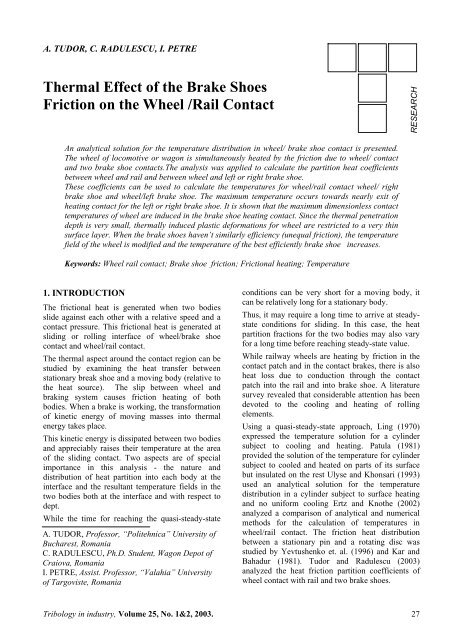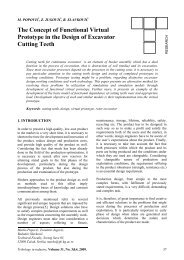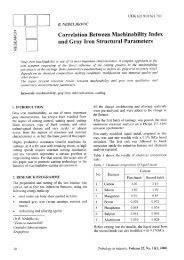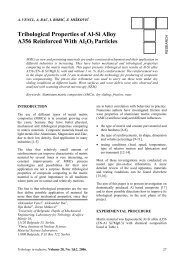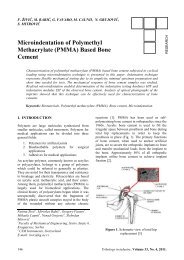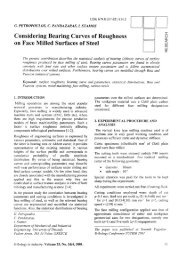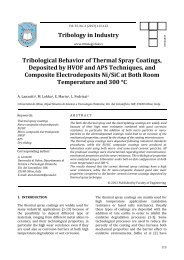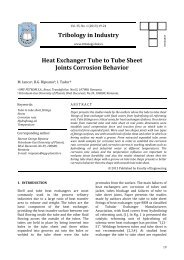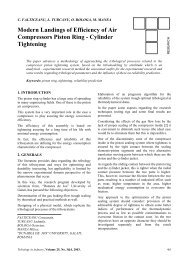Thermal Effect of the Brake Shoes Friction on the Wheel /Rail Contact
Thermal Effect of the Brake Shoes Friction on the Wheel /Rail Contact
Thermal Effect of the Brake Shoes Friction on the Wheel /Rail Contact
- No tags were found...
You also want an ePaper? Increase the reach of your titles
YUMPU automatically turns print PDFs into web optimized ePapers that Google loves.
A. TUDOR, C. RADULESCU, I. PETRE<str<strong>on</strong>g>Thermal</str<strong>on</strong>g> <str<strong>on</strong>g>Effect</str<strong>on</strong>g> <str<strong>on</strong>g>of</str<strong>on</strong>g> <str<strong>on</strong>g>the</str<strong>on</strong>g> <str<strong>on</strong>g>Brake</str<strong>on</strong>g> <str<strong>on</strong>g>Shoes</str<strong>on</strong>g><str<strong>on</strong>g>Fricti<strong>on</strong></str<strong>on</strong>g> <strong>on</strong> <str<strong>on</strong>g>the</str<strong>on</strong>g> <strong>Wheel</strong> /<strong>Rail</strong> C<strong>on</strong>tactRESEARCHAn analytical soluti<strong>on</strong> for <str<strong>on</strong>g>the</str<strong>on</strong>g> temperature distributi<strong>on</strong> in wheel/ brake shoe c<strong>on</strong>tact is presented.The wheel <str<strong>on</strong>g>of</str<strong>on</strong>g> locomotive or wag<strong>on</strong> is simultaneously heated by <str<strong>on</strong>g>the</str<strong>on</strong>g> fricti<strong>on</strong> due to wheel/ c<strong>on</strong>tactand two brake shoe c<strong>on</strong>tacts.The analysis was applied to calculate <str<strong>on</strong>g>the</str<strong>on</strong>g> partiti<strong>on</strong> heat coefficientsbetween wheel and rail and between wheel and left or right brake shoe.These coefficients can be used to calculate <str<strong>on</strong>g>the</str<strong>on</strong>g> temperatures for wheel/rail c<strong>on</strong>tact wheel/ rightbrake shoe and wheel/left brake shoe. The maximum temperature occurs towards nearly exit <str<strong>on</strong>g>of</str<strong>on</strong>g>heating c<strong>on</strong>tact for <str<strong>on</strong>g>the</str<strong>on</strong>g> left or right brake shoe. It is shown that <str<strong>on</strong>g>the</str<strong>on</strong>g> maximum dimensi<strong>on</strong>less c<strong>on</strong>tacttemperatures <str<strong>on</strong>g>of</str<strong>on</strong>g> wheel are induced in <str<strong>on</strong>g>the</str<strong>on</strong>g> brake shoe heating c<strong>on</strong>tact. Since <str<strong>on</strong>g>the</str<strong>on</strong>g> <str<strong>on</strong>g>the</str<strong>on</strong>g>rmal penetrati<strong>on</strong>depth is very small, <str<strong>on</strong>g>the</str<strong>on</strong>g>rmally induced plastic deformati<strong>on</strong>s for wheel are restricted to a very thinsurface layer. When <str<strong>on</strong>g>the</str<strong>on</strong>g> brake shoes haven’t similarly efficiency (unequal fricti<strong>on</strong>), <str<strong>on</strong>g>the</str<strong>on</strong>g> temperaturefield <str<strong>on</strong>g>of</str<strong>on</strong>g> <str<strong>on</strong>g>the</str<strong>on</strong>g> wheel is modified and <str<strong>on</strong>g>the</str<strong>on</strong>g> temperature <str<strong>on</strong>g>of</str<strong>on</strong>g> <str<strong>on</strong>g>the</str<strong>on</strong>g> best efficiently brake shoe increases.Keywords: <strong>Wheel</strong> rail c<strong>on</strong>tact; <str<strong>on</strong>g>Brake</str<strong>on</strong>g> shoe fricti<strong>on</strong>; <str<strong>on</strong>g>Fricti<strong>on</strong></str<strong>on</strong>g>al heating; Temperature1. INTRODUCTIONThe fricti<strong>on</strong>al heat is generated when two bodiesslide against each o<str<strong>on</strong>g>the</str<strong>on</strong>g>r with a relative speed and ac<strong>on</strong>tact pressure. This fricti<strong>on</strong>al heat is generated atsliding or rolling interface <str<strong>on</strong>g>of</str<strong>on</strong>g> wheel/brake shoec<strong>on</strong>tact and wheel/rail c<strong>on</strong>tact.The <str<strong>on</strong>g>the</str<strong>on</strong>g>rmal aspect around <str<strong>on</strong>g>the</str<strong>on</strong>g> c<strong>on</strong>tact regi<strong>on</strong> can bestudied by examining <str<strong>on</strong>g>the</str<strong>on</strong>g> heat transfer betweenstati<strong>on</strong>ary break shoe and a moving body (relative to<str<strong>on</strong>g>the</str<strong>on</strong>g> heat source). The slip between wheel andbraking system causes fricti<strong>on</strong> heating <str<strong>on</strong>g>of</str<strong>on</strong>g> bothbodies. When a brake is working, <str<strong>on</strong>g>the</str<strong>on</strong>g> transformati<strong>on</strong><str<strong>on</strong>g>of</str<strong>on</strong>g> kinetic energy <str<strong>on</strong>g>of</str<strong>on</strong>g> moving masses into <str<strong>on</strong>g>the</str<strong>on</strong>g>rmalenergy takes place.This kinetic energy is dissipated between two bodiesand appreciably raises <str<strong>on</strong>g>the</str<strong>on</strong>g>ir temperature at <str<strong>on</strong>g>the</str<strong>on</strong>g> area<str<strong>on</strong>g>of</str<strong>on</strong>g> <str<strong>on</strong>g>the</str<strong>on</strong>g> sliding c<strong>on</strong>tact. Two aspects are <str<strong>on</strong>g>of</str<strong>on</strong>g> specialimportance in this analysis - <str<strong>on</strong>g>the</str<strong>on</strong>g> nature anddistributi<strong>on</strong> <str<strong>on</strong>g>of</str<strong>on</strong>g> heat partiti<strong>on</strong> into each body at <str<strong>on</strong>g>the</str<strong>on</strong>g>interface and <str<strong>on</strong>g>the</str<strong>on</strong>g> resultant temperature fields in <str<strong>on</strong>g>the</str<strong>on</strong>g>two bodies both at <str<strong>on</strong>g>the</str<strong>on</strong>g> interface and with respect todept.While <str<strong>on</strong>g>the</str<strong>on</strong>g> time for reaching <str<strong>on</strong>g>the</str<strong>on</strong>g> quasi-steady-stateA. TUDOR, Pr<str<strong>on</strong>g>of</str<strong>on</strong>g>essor, “Politehnica” University <str<strong>on</strong>g>of</str<strong>on</strong>g>Bucharest, RomaniaC. RADULESCU, Ph.D. Student, Wag<strong>on</strong> Depot <str<strong>on</strong>g>of</str<strong>on</strong>g>Craiova, RomaniaI. PETRE, Assist. Pr<str<strong>on</strong>g>of</str<strong>on</strong>g>essor, “Valahia” University<str<strong>on</strong>g>of</str<strong>on</strong>g> Targoviste, Romaniac<strong>on</strong>diti<strong>on</strong>s can be very short for a moving body, itcan be relatively l<strong>on</strong>g for a stati<strong>on</strong>ary body.Thus, it may require a l<strong>on</strong>g time to arrive at steadystatec<strong>on</strong>diti<strong>on</strong>s for sliding. In this case, <str<strong>on</strong>g>the</str<strong>on</strong>g> heatpartiti<strong>on</strong> fracti<strong>on</strong>s for <str<strong>on</strong>g>the</str<strong>on</strong>g> two bodies may also varyfor a l<strong>on</strong>g time before reaching steady-state value.While railway wheels are heating by fricti<strong>on</strong> in <str<strong>on</strong>g>the</str<strong>on</strong>g>c<strong>on</strong>tact patch and in <str<strong>on</strong>g>the</str<strong>on</strong>g> c<strong>on</strong>tact brakes, <str<strong>on</strong>g>the</str<strong>on</strong>g>re is alsoheat loss due to c<strong>on</strong>ducti<strong>on</strong> through <str<strong>on</strong>g>the</str<strong>on</strong>g> c<strong>on</strong>tactpatch into <str<strong>on</strong>g>the</str<strong>on</strong>g> rail and into brake shoe. A literaturesurvey revealed that c<strong>on</strong>siderable attenti<strong>on</strong> has beendevoted to <str<strong>on</strong>g>the</str<strong>on</strong>g> cooling and heating <str<strong>on</strong>g>of</str<strong>on</strong>g> rollingelements.Using a quasi-steady-state approach, Ling (1970)expressed <str<strong>on</strong>g>the</str<strong>on</strong>g> temperature soluti<strong>on</strong> for a cylindersubject to cooling and heating. Patula (1981)provided <str<strong>on</strong>g>the</str<strong>on</strong>g> soluti<strong>on</strong> <str<strong>on</strong>g>of</str<strong>on</strong>g> <str<strong>on</strong>g>the</str<strong>on</strong>g> temperature for cylindersubject to cooled and heated <strong>on</strong> parts <str<strong>on</strong>g>of</str<strong>on</strong>g> its surfacebut insulated <strong>on</strong> <str<strong>on</strong>g>the</str<strong>on</strong>g> rest Ulyse and Kh<strong>on</strong>sari (1993)used an analytical soluti<strong>on</strong> for <str<strong>on</strong>g>the</str<strong>on</strong>g> temperaturedistributi<strong>on</strong> in a cylinder subject to surface heatingand no uniform cooling Ertz and Kno<str<strong>on</strong>g>the</str<strong>on</strong>g> (2002)analyzed a comparis<strong>on</strong> <str<strong>on</strong>g>of</str<strong>on</strong>g> analytical and numericalmethods for <str<strong>on</strong>g>the</str<strong>on</strong>g> calculati<strong>on</strong> <str<strong>on</strong>g>of</str<strong>on</strong>g> temperatures inwheel/rail c<strong>on</strong>tact. The fricti<strong>on</strong> heat distributi<strong>on</strong>between a stati<strong>on</strong>ary pin and a rotating disc wasstudied by Yevtushenko et. al. (1996) and Kar andBahadur (1981). Tudor and Radulescu (2003)analyzed <str<strong>on</strong>g>the</str<strong>on</strong>g> heat fricti<strong>on</strong> partiti<strong>on</strong> coefficients <str<strong>on</strong>g>of</str<strong>on</strong>g>wheel c<strong>on</strong>tact with rail and two brake shoes.Tribology in industry, Volume 25, No. 1&2, 2003. 27
α+α oC 5RCαωα’q 3γ 3γ q 2φC 6 γC 2α’Cα+α 1 oαOq 12δFigure 1. Geometry and boundary c<strong>on</strong>diti<strong>on</strong>sIn this paper, an analytical soluti<strong>on</strong> for <str<strong>on</strong>g>the</str<strong>on</strong>g> fricti<strong>on</strong>heat temperature distributi<strong>on</strong> in a wheel subject tosurface heating by rolling in rail c<strong>on</strong>tact and subjectto two surfaces heating by sliding in brake shoes ispresented. This also n<strong>on</strong>uniforming cooling isshown. The fricti<strong>on</strong> temperature distributi<strong>on</strong> isobtained by a Fourier transform technique.2. THE FRICTION HEAT TRANSFERMODEL OF WHEELThe wheel is c<strong>on</strong>sidered that a short rotatingcylinder. This wheel, subjected to heating by rollingand sliding fricti<strong>on</strong> and no uniform c<strong>on</strong>vectivecooling at arbitrary angles (β c ) al<strong>on</strong>g <str<strong>on</strong>g>the</str<strong>on</strong>g>circumference, is shown in Fig. 1. In this paper, weused <str<strong>on</strong>g>the</str<strong>on</strong>g> model presented in [9].The relative positi<strong>on</strong>s <str<strong>on</strong>g>of</str<strong>on</strong>g> <str<strong>on</strong>g>the</str<strong>on</strong>g> rail and <str<strong>on</strong>g>the</str<strong>on</strong>g> bra-ke shoeswill be analyzed by <str<strong>on</strong>g>the</str<strong>on</strong>g> angular locati<strong>on</strong>. Heating isassumed be provided by means <str<strong>on</strong>g>of</str<strong>on</strong>g> rol-ling fricti<strong>on</strong> in<str<strong>on</strong>g>the</str<strong>on</strong>g> angular (γ a ) and means <str<strong>on</strong>g>of</str<strong>on</strong>g> sli-ding fricti<strong>on</strong> in <str<strong>on</strong>g>the</str<strong>on</strong>g>two intervals γ 2 and γ 3 (Fig. 1).External cooling is assumed to be provided bymeans <str<strong>on</strong>g>of</str<strong>on</strong>g> airflow c<strong>on</strong>vective heat transfer(c<strong>on</strong>vecti<strong>on</strong> coefficient α) in <str<strong>on</strong>g>the</str<strong>on</strong>g> interval (C 1 , C 2 )and (C 3 , C 4 ) and by forced c<strong>on</strong>vecti<strong>on</strong> heat transfer(c<strong>on</strong>vecti<strong>on</strong> coefficient α+α o ) in <str<strong>on</strong>g>the</str<strong>on</strong>g> interval (C 4 , C 5 )and (C 6 , 0) (fig. 1).It is used <str<strong>on</strong>g>the</str<strong>on</strong>g> following dimensi<strong>on</strong>less variablesλTr R1 αRθ = ; ρ = ; ρ1= ;Bi= ;q R R R1λ2αoRα'R q2q3Bio= ; Bis= ; qa2= ; q3=λ λ ⋅ 2 ⋅ δ q1q1The heat c<strong>on</strong>ducti<strong>on</strong> equati<strong>on</strong> in dimensi<strong>on</strong>lessvariables is2∂ θ 1+2∂ρ ρ∂θ∂ρ1+2ρ2∂ θ= B2∂φisθ(1)The soluti<strong>on</strong> <str<strong>on</strong>g>of</str<strong>on</strong>g> differential equati<strong>on</strong> to accepct <str<strong>on</strong>g>the</str<strong>on</strong>g>boundary c<strong>on</strong>diti<strong>on</strong>s will be writing as [9]:θ ( ρ,ψ)= θ ε + θ ε + θ ε(2)o11o2The dimensi<strong>on</strong>less parameter θ o1 , θ o2 and θ o3 aredefined in [9]. In order to calculate <str<strong>on</strong>g>the</str<strong>on</strong>g> temperaturerise <str<strong>on</strong>g>of</str<strong>on</strong>g> <str<strong>on</strong>g>the</str<strong>on</strong>g> disc with <str<strong>on</strong>g>the</str<strong>on</strong>g> dimensi<strong>on</strong>less radius ρ = ρ 1and ρ = 1 using equati<strong>on</strong> (1), <str<strong>on</strong>g>the</str<strong>on</strong>g> heat distributi<strong>on</strong>coefficients (ε 1 , ε 2 , ε 3 ) are evaluated by Tudor andRadulescu [9].3. HEAT ROLLING FRICTIONTEMPERATUREThe heat rolling fricti<strong>on</strong> distributi<strong>on</strong> coefficient (ε1)is <str<strong>on</strong>g>the</str<strong>on</strong>g> ratio <str<strong>on</strong>g>of</str<strong>on</strong>g> <str<strong>on</strong>g>the</str<strong>on</strong>g> amount <str<strong>on</strong>g>of</str<strong>on</strong>g> heat energy flowing into<str<strong>on</strong>g>the</str<strong>on</strong>g> wheel, as a disc to <str<strong>on</strong>g>the</str<strong>on</strong>g> total heat generated at <str<strong>on</strong>g>the</str<strong>on</strong>g>rolling interface wheel/rail c<strong>on</strong>tact.When wheel and rail are brought into c<strong>on</strong>tact under<str<strong>on</strong>g>the</str<strong>on</strong>g> acti<strong>on</strong> <str<strong>on</strong>g>of</str<strong>on</strong>g> <str<strong>on</strong>g>the</str<strong>on</strong>g> static wheel load, <str<strong>on</strong>g>the</str<strong>on</strong>g> area <str<strong>on</strong>g>of</str<strong>on</strong>g>c<strong>on</strong>tact and <str<strong>on</strong>g>the</str<strong>on</strong>g> pressure distributi<strong>on</strong> are usuallycalculated with <str<strong>on</strong>g>the</str<strong>on</strong>g> Hertz’s <str<strong>on</strong>g>the</str<strong>on</strong>g>ory. If a tangentialforce T is transmitted between wheel and rail, <str<strong>on</strong>g>the</str<strong>on</strong>g>reis always a mean relative velocity in <str<strong>on</strong>g>the</str<strong>on</strong>g> c<strong>on</strong>tactpoint. Sliding occurs within <str<strong>on</strong>g>the</str<strong>on</strong>g> whole c<strong>on</strong>tact areaand <str<strong>on</strong>g>the</str<strong>on</strong>g> tangential force is T = μNw (Nw – wheelload).The c<strong>on</strong>tact patch moves with respect to <str<strong>on</strong>g>the</str<strong>on</strong>g> wheelsurface and <str<strong>on</strong>g>the</str<strong>on</strong>g> fricti<strong>on</strong> heating within <str<strong>on</strong>g>the</str<strong>on</strong>g> c<strong>on</strong>tactpatch is a time dependent heat source (Fig. 2).With <str<strong>on</strong>g>the</str<strong>on</strong>g> typical values for wheel/rail c<strong>on</strong>tact, aH ≅5 mm, ar = 14,2⋅10-6 m2/s and vo=26 m/s, <strong>on</strong>e getsL = 4584. In this case, <str<strong>on</strong>g>the</str<strong>on</strong>g> l<strong>on</strong>gitudinal and lateral2o3328Tribology in industry, Volume 25, No. 1&2, 2003.
heat c<strong>on</strong>ducti<strong>on</strong> (x – and y – directi<strong>on</strong>), can,<str<strong>on</strong>g>the</str<strong>on</strong>g>refore, be neglected and heat c<strong>on</strong>ducti<strong>on</strong> equati<strong>on</strong>is [8]ar2∂ T2∂zr∂T=∂tr(3)Thus, T r represents <str<strong>on</strong>g>the</str<strong>on</strong>g> temperature rail rise due to<str<strong>on</strong>g>the</str<strong>on</strong>g> heat supply within <str<strong>on</strong>g>the</str<strong>on</strong>g> c<strong>on</strong>tact patch.Since <str<strong>on</strong>g>the</str<strong>on</strong>g> heat flew is <strong>on</strong>e-dimensi<strong>on</strong>al, this problemis similar to a semi-infinite solid with an arbitrarilydistributed heat source q 1 (t) applied to <str<strong>on</strong>g>the</str<strong>on</strong>g> surface z= 0 at t ≥ 0. The soluti<strong>on</strong> T r (z,t) has to fulfil <str<strong>on</strong>g>the</str<strong>on</strong>g>differential equati<strong>on</strong> (3), <str<strong>on</strong>g>the</str<strong>on</strong>g> initial c<strong>on</strong>diti<strong>on</strong>T r(z, t = 0) = 0and <str<strong>on</strong>g>the</str<strong>on</strong>g> boundary c<strong>on</strong>diti<strong>on</strong>− λr∂Tr(z =∂z0, t)= q1r(t) = (1 − ε1)q1(t)(4)(5)The soluti<strong>on</strong> <str<strong>on</strong>g>of</str<strong>on</strong>g> this problem can be found in <str<strong>on</strong>g>the</str<strong>on</strong>g>book <str<strong>on</strong>g>of</str<strong>on</strong>g> Carslaw and Jaeger,a trTr(z, t) = ∫ qλ πr⎛ z(t − t')exp⎜ −⎝ 4a1r0 r2⎟ ⎞t' ⎠dt't'(6)The points <strong>on</strong> <str<strong>on</strong>g>the</str<strong>on</strong>g> surface <str<strong>on</strong>g>of</str<strong>on</strong>g> wheel and rail passthrough <str<strong>on</strong>g>the</str<strong>on</strong>g> c<strong>on</strong>tact patch at different speeds due to<str<strong>on</strong>g>the</str<strong>on</strong>g> sliding velocity.The largest heat flux and <str<strong>on</strong>g>the</str<strong>on</strong>g> highest temperaturesrecur <str<strong>on</strong>g>the</str<strong>on</strong>g> major hertzian axis which is parallel to <str<strong>on</strong>g>the</str<strong>on</strong>g>rolling directi<strong>on</strong> at y=0. It is meaningful to substitute<str<strong>on</strong>g>the</str<strong>on</strong>g> time t elapsed since entering <str<strong>on</strong>g>the</str<strong>on</strong>g> c<strong>on</strong>tact patchwith <str<strong>on</strong>g>the</str<strong>on</strong>g> current positi<strong>on</strong> x in a coordinate systemfixed to <str<strong>on</strong>g>the</str<strong>on</strong>g> c<strong>on</strong>tact patch (Fig. 2)x = vt −a HWith <str<strong>on</strong>g>the</str<strong>on</strong>g> dimensi<strong>on</strong>less coordinatesx =axaHzz a=and zδ ,<str<strong>on</strong>g>the</str<strong>on</strong>g> temperature <str<strong>on</strong>g>of</str<strong>on</strong>g> rail (T r ) can be calculated asT ( zx a∫r−1q1ra,x( x'aa) =λarraHπv'⎛ dxa)exp⎜−'⎝ 2( x − xaoa⎞⎟⎠a(7)'dxa'x − xa(8)The analytical soluti<strong>on</strong> <str<strong>on</strong>g>of</str<strong>on</strong>g> <str<strong>on</strong>g>the</str<strong>on</strong>g> integral in equati<strong>on</strong> (8)is quite simple if we assume a c<strong>on</strong>stant heat flowrate q 1r at <str<strong>on</strong>g>the</str<strong>on</strong>g> rail surface within <str<strong>on</strong>g>the</str<strong>on</strong>g> c<strong>on</strong>tact patch.The fricti<strong>on</strong>al power dissipati<strong>on</strong> rate in rollingc<strong>on</strong>tact patch is proporti<strong>on</strong>al to <str<strong>on</strong>g>the</str<strong>on</strong>g> pressures, <str<strong>on</strong>g>the</str<strong>on</strong>g>coefficient <str<strong>on</strong>g>of</str<strong>on</strong>g> fricti<strong>on</strong> μ and <str<strong>on</strong>g>the</str<strong>on</strong>g> sliding velocity ascan be c<strong>on</strong>sidered c<strong>on</strong>stant values:q21(xa) = μvspz(xa) = μvspo1−xaThe average heat flow at <str<strong>on</strong>g>the</str<strong>on</strong>g> surface11πq1 = ∫ q1(xa)dxa= μvsp2 −14o(9)(10)It is generally assumed that <str<strong>on</strong>g>the</str<strong>on</strong>g> fricti<strong>on</strong>al powerdissipati<strong>on</strong> is transformed in heat. With <str<strong>on</strong>g>the</str<strong>on</strong>g> heatpartiti<strong>on</strong> factor ε 1 , this can be written asq (x ) qand1wa= ε1q1 r(xa) = (1 − ε1(xa)1)q1(xa)for railfor wheel (11)The maximum temperature occurs at <str<strong>on</strong>g>the</str<strong>on</strong>g> trailingedge <str<strong>on</strong>g>of</str<strong>on</strong>g> <str<strong>on</strong>g>the</str<strong>on</strong>g> c<strong>on</strong>tact patch.For this case, dimensi<strong>on</strong>less temperature <str<strong>on</strong>g>of</str<strong>on</strong>g> discsurface iswithCrTr(0,1) λdθ r =qR=8aHar2πRvsλλdr= C.r− ε C1r(12)The part <str<strong>on</strong>g>of</str<strong>on</strong>g> <str<strong>on</strong>g>the</str<strong>on</strong>g> rolling fricti<strong>on</strong>al heating (ε 1 ) thatflows into wheel can be defined with equati<strong>on</strong>s (2)and (12):θ( 1, β ε1)= Cr−1CrThe angle β 1 = γ 1 = 2 asin (a H /R).(13)For example, <str<strong>on</strong>g>the</str<strong>on</strong>g> normal c<strong>on</strong>diti<strong>on</strong>s <str<strong>on</strong>g>of</str<strong>on</strong>g> wheel/railc<strong>on</strong>tact are wheel load Fn= 100 kN, wheel radius R=0,5 m, vehicle speed vo= 26 m/s, sliding velocity(l<strong>on</strong>gitudinal), vs= 1 m/s, semi-axis <str<strong>on</strong>g>of</str<strong>on</strong>g> <str<strong>on</strong>g>the</str<strong>on</strong>g> c<strong>on</strong>tactellipse in rolling directi<strong>on</strong> a H = 5,88 mm. In this caseβ 1 = γ 1 = 0,024 rad.4. HEAT SLIDING FRICTIONTEMPERATURE DISTRIBUTIONC<strong>on</strong>sidering <str<strong>on</strong>g>the</str<strong>on</strong>g> heat transfer by c<strong>on</strong>diti<strong>on</strong> al<strong>on</strong>g <str<strong>on</strong>g>the</str<strong>on</strong>g>length <str<strong>on</strong>g>of</str<strong>on</strong>g> <str<strong>on</strong>g>the</str<strong>on</strong>g> brake shoe and by c<strong>on</strong>vecti<strong>on</strong> from <str<strong>on</strong>g>the</str<strong>on</strong>g>periphery (Fig. 3), <str<strong>on</strong>g>the</str<strong>on</strong>g> differential equati<strong>on</strong> for <str<strong>on</strong>g>the</str<strong>on</strong>g>temperature distribu-ti<strong>on</strong> at any axis distance z isgivenTribology in industry, Volume 25, No. 1&2, 2003. 29
2∂ T αbp−2∂zλ Abbb(T − T )o(14)where λ b is <str<strong>on</strong>g>the</str<strong>on</strong>g>rmal c<strong>on</strong>ductivity <str<strong>on</strong>g>of</str<strong>on</strong>g> <str<strong>on</strong>g>the</str<strong>on</strong>g> brake shoematerial, T <str<strong>on</strong>g>the</str<strong>on</strong>g> temperature in <str<strong>on</strong>g>the</str<strong>on</strong>g> brake shoe at anyaxial distance z, T o <str<strong>on</strong>g>the</str<strong>on</strong>g> ambient temperature and, α b<str<strong>on</strong>g>the</str<strong>on</strong>g> heat transfer coefficient for <str<strong>on</strong>g>the</str<strong>on</strong>g> brake shoe, p b ,A b <str<strong>on</strong>g>the</str<strong>on</strong>g> perimeter and cross-secti<strong>on</strong>al area <str<strong>on</strong>g>of</str<strong>on</strong>g> <str<strong>on</strong>g>the</str<strong>on</strong>g>brake shoe.Substituting T b =T-T o and m b =(α b p b /λ b A b ) 1/2 , <str<strong>on</strong>g>the</str<strong>on</strong>g>general soluti<strong>on</strong> <str<strong>on</strong>g>of</str<strong>on</strong>g> equati<strong>on</strong> (14) is given bymbz−mzTb= Ae + Be b, A and B are <str<strong>on</strong>g>the</str<strong>on</strong>g> c<strong>on</strong>stantswhich are defined by boundary c<strong>on</strong>diti<strong>on</strong>s.With <str<strong>on</strong>g>the</str<strong>on</strong>g> boundary c<strong>on</strong>diti<strong>on</strong>sTb= 0, z = g b(15)λb∂T∂z= −q= −(1− ε) qb2b2 2z= 0(16)andTb = Ts2, z = 0(17)<str<strong>on</strong>g>the</str<strong>on</strong>g> soluti<strong>on</strong> <str<strong>on</strong>g>of</str<strong>on</strong>g> equati<strong>on</strong> (14) becomes:Tssinh{ mb(gb− z) }Tb(z) =sinh(mbgb)(18)The sliding fricti<strong>on</strong>al power dissipati<strong>on</strong> rate in <str<strong>on</strong>g>the</str<strong>on</strong>g>c<strong>on</strong>tact patch <str<strong>on</strong>g>of</str<strong>on</strong>g> wheel and brake shoe isq v p (x)proporti<strong>on</strong>al to <str<strong>on</strong>g>the</str<strong>on</strong>g> pressure2= μ b o b.We assume that fricti<strong>on</strong> coefficient (μ b ) and pressurep b (x) are c<strong>on</strong>stants and that all <str<strong>on</strong>g>the</str<strong>on</strong>g> fricti<strong>on</strong>al powerdissipati<strong>on</strong> is transformed in heat.Using equati<strong>on</strong>s (18) and (16) can be calculated <str<strong>on</strong>g>the</str<strong>on</strong>g>surface brake shoe temperatureTs2(1 − ε=λ2b)q21mtanh(mDimensi<strong>on</strong>less temperature <str<strong>on</strong>g>of</str<strong>on</strong>g> brake shoe surfacewithqθCs2b2a 2Ts2λd=q Rq=q1q=λ12a 2a 2,= Cba2b2−ε C2bdb21tanh(mm Rλλ=λbgb)bgb)and(41).(19)α bγ 2t'R dxFigure 3. Co-ordinate system for temperaturecalculati<strong>on</strong> in wheel/brake shoe c<strong>on</strong>tactThe partiti<strong>on</strong> coefficient ε 2 will be calculated wi<str<strong>on</strong>g>the</str<strong>on</strong>g>quati<strong>on</strong>s (19) and (2)⎛ γ ⎞θ⎜1,βε⎝ 2 ⎠22+ ⎟ = Cb2−2Cb2It is generally assumed that every wheel has twobrake shoes. The relative positi<strong>on</strong> is defined by <str<strong>on</strong>g>the</str<strong>on</strong>g>angles β 2 , β 3 , γ 2 and γ 3 for <str<strong>on</strong>g>the</str<strong>on</strong>g> left (b 2 ) and rightbrake shoe (b 3 ) (Fig. 4).The partiti<strong>on</strong> heat coefficient for every brake shoe(ε 2 and ε 3 ) are calculated by c<strong>on</strong>diti<strong>on</strong>s that <str<strong>on</strong>g>the</str<strong>on</strong>g>temperature for <str<strong>on</strong>g>the</str<strong>on</strong>g> wheel and rail, left brake shoeand right brake shoe are respectively equal.5. STEADY-STATE WHEELTEMPERATUREThe bulk temperature <str<strong>on</strong>g>of</str<strong>on</strong>g> <str<strong>on</strong>g>the</str<strong>on</strong>g> wheel increases withtime due to c<strong>on</strong>tinuous fricti<strong>on</strong>al heating <strong>on</strong> itsrolling surface.Therefore, <str<strong>on</strong>g>the</str<strong>on</strong>g> temperatures <str<strong>on</strong>g>of</str<strong>on</strong>g> wheel and rail aredifferent when a point <strong>on</strong> <str<strong>on</strong>g>the</str<strong>on</strong>g> surface <str<strong>on</strong>g>of</str<strong>on</strong>g> <str<strong>on</strong>g>the</str<strong>on</strong>g> wheelcomes into in <str<strong>on</strong>g>the</str<strong>on</strong>g> area <str<strong>on</strong>g>of</str<strong>on</strong>g> c<strong>on</strong>tact again. This givesrise to a c<strong>on</strong>siderable heat flow from <str<strong>on</strong>g>the</str<strong>on</strong>g> hot wheelinto <str<strong>on</strong>g>the</str<strong>on</strong>g> cold rail due to c<strong>on</strong>ducti<strong>on</strong> through <str<strong>on</strong>g>the</str<strong>on</strong>g>c<strong>on</strong>tact patch.Outside <str<strong>on</strong>g>the</str<strong>on</strong>g> area <str<strong>on</strong>g>of</str<strong>on</strong>g> c<strong>on</strong>tract, fricti<strong>on</strong>al heat flowsfrom <str<strong>on</strong>g>the</str<strong>on</strong>g> wheel into ambient air by c<strong>on</strong>vecti<strong>on</strong> at <str<strong>on</strong>g>the</str<strong>on</strong>g>free surfaces.During <str<strong>on</strong>g>the</str<strong>on</strong>g> very short time period that every point <strong>on</strong><str<strong>on</strong>g>the</str<strong>on</strong>g> surface is in rolling c<strong>on</strong>tact, he <str<strong>on</strong>g>the</str<strong>on</strong>g>rmalpenetrati<strong>on</strong> depth is very small compared to <str<strong>on</strong>g>the</str<strong>on</strong>g> sizezα b30Tribology in industry, Volume 25, No. 1&2, 2003.
<str<strong>on</strong>g>of</str<strong>on</strong>g> <str<strong>on</strong>g>the</str<strong>on</strong>g> c<strong>on</strong>tact patch. With <str<strong>on</strong>g>the</str<strong>on</strong>g> boundary c<strong>on</strong>diti<strong>on</strong>s,<str<strong>on</strong>g>the</str<strong>on</strong>g> wheel it is c<strong>on</strong>sidered as a central disc and a thinannulus. This thin annulus <str<strong>on</strong>g>of</str<strong>on</strong>g> <str<strong>on</strong>g>the</str<strong>on</strong>g> disc is affected bytemperature oscillati<strong>on</strong>.bCCCOFigure 4. Relative positi<strong>on</strong> <str<strong>on</strong>g>of</str<strong>on</strong>g> heat sourcesThe dimensi<strong>on</strong>less temperature <str<strong>on</strong>g>of</str<strong>on</strong>g> <str<strong>on</strong>g>the</str<strong>on</strong>g> central discTcλdθc= =q R1ε γ +ε γ q +ε γ q λ1 1 2 2 a2 3 3 a3dR R( β − γ − γ ) α+ (2π−β− γ ) α + π α'c 1 2c 3 oδ(21)6. RESULTS AND DISCUSSIONThe dimensi<strong>on</strong>less wheel surface tempe-ratureθ(1,ψ) as <str<strong>on</strong>g>the</str<strong>on</strong>g> angular locati<strong>on</strong> is shown in <str<strong>on</strong>g>the</str<strong>on</strong>g> fig. 5for different values <str<strong>on</strong>g>of</str<strong>on</strong>g> Biot’s number (0.2,1,5).The local temperature rise around <str<strong>on</strong>g>the</str<strong>on</strong>g> heat sourcesdecreases with increase <str<strong>on</strong>g>of</str<strong>on</strong>g> <str<strong>on</strong>g>the</str<strong>on</strong>g> parameter B io .On notices that <str<strong>on</strong>g>the</str<strong>on</strong>g> maximum temperature in Fig. 5,when <str<strong>on</strong>g>the</str<strong>on</strong>g> two brake shoes have equals fricti<strong>on</strong>efficiently, is between wheel and <str<strong>on</strong>g>the</str<strong>on</strong>g> left brakeshoes. This can be explained by examining <str<strong>on</strong>g>the</str<strong>on</strong>g>fricti<strong>on</strong> <str<strong>on</strong>g>the</str<strong>on</strong>g>rmal history <str<strong>on</strong>g>of</str<strong>on</strong>g> a material element. Apoint uniformly heated by <str<strong>on</strong>g>the</str<strong>on</strong>g> heat sources increasesits temperature significantly to reach a maximum at<str<strong>on</strong>g>the</str<strong>on</strong>g> end <str<strong>on</strong>g>of</str<strong>on</strong>g> <str<strong>on</strong>g>the</str<strong>on</strong>g> heating wits.The cooling and heating less affect points inside <str<strong>on</strong>g>the</str<strong>on</strong>g>wheel. For this cyclically steady-state problem, dueto <str<strong>on</strong>g>the</str<strong>on</strong>g> length <str<strong>on</strong>g>of</str<strong>on</strong>g> time needed for <str<strong>on</strong>g>the</str<strong>on</strong>g> heat to bec<strong>on</strong>ducted into <str<strong>on</strong>g>the</str<strong>on</strong>g> inner layers, <str<strong>on</strong>g>the</str<strong>on</strong>g> maximumtemperatures at interior locati<strong>on</strong>s are always shiftedin <str<strong>on</strong>g>the</str<strong>on</strong>g> directi<strong>on</strong> <str<strong>on</strong>g>of</str<strong>on</strong>g> rotati<strong>on</strong>.ωCrCCbDimensi<strong>on</strong>less surface wheel temperature0.0020.0010.0010.0020Bi = 0.210 2 4 6 8Angular locati<strong>on</strong> (radian)5q a2 = 0.010q a3 = 0.024Figure 5. Surface wheel temperatureThis point is <str<strong>on</strong>g>the</str<strong>on</strong>g>n cooled as <str<strong>on</strong>g>the</str<strong>on</strong>g> results <str<strong>on</strong>g>of</str<strong>on</strong>g> c<strong>on</strong>vectivecooling as well as circumferential and radial heatc<strong>on</strong>ducti<strong>on</strong>.Figure 6 presents <str<strong>on</strong>g>the</str<strong>on</strong>g> temperature pr<str<strong>on</strong>g>of</str<strong>on</strong>g>ile for <str<strong>on</strong>g>the</str<strong>on</strong>g> casewhere <str<strong>on</strong>g>the</str<strong>on</strong>g> brake shoes haven’t similarly efficiency.The negative values <str<strong>on</strong>g>of</str<strong>on</strong>g> <str<strong>on</strong>g>the</str<strong>on</strong>g> dimensi-<strong>on</strong>lesstemperatures show that cooling by c<strong>on</strong>vec-ti<strong>on</strong> ishigher than <str<strong>on</strong>g>the</str<strong>on</strong>g> rolling fricti<strong>on</strong> heating.Dimensi<strong>on</strong>less surface wheel temperatureθ 1 ( ψ)θ 2 ( ψ)θ 3 ( ψ)0.0020.00100.001Bi = 0.210.0020 2 4 6 85q a2 = q a3 = 0.01ψAngular locati<strong>on</strong> (radian)Figure 6. Surface wheel temperatureThe data in Table 1 are usual operating c<strong>on</strong>diti<strong>on</strong>s <str<strong>on</strong>g>of</str<strong>on</strong>g>European locomotives and wag<strong>on</strong>s at <str<strong>on</strong>g>the</str<strong>on</strong>g> low andhigh speed or carriages at <str<strong>on</strong>g>the</str<strong>on</strong>g> low speed [8]. Themaximum temperatures are evaluated for <str<strong>on</strong>g>the</str<strong>on</strong>g>sec<strong>on</strong>diti<strong>on</strong>s.7. CONCLUSIONSAn analytical soluti<strong>on</strong> is presented for <str<strong>on</strong>g>the</str<strong>on</strong>g>temperature distributi<strong>on</strong> <str<strong>on</strong>g>of</str<strong>on</strong>g> rotating wheel (cylinder)subjected to no uniform cooling and three uniformfricti<strong>on</strong> heating...Tribology in industry, Volume 25, No. 1&2, 2003. 31
Table 1.Units Low speed High speedNormal load [8] F n (kN) 100 100Vehicle speed [8] v o (m/s) 30 90Sliding velocity (l<strong>on</strong>gitudinal) [8] v s (m/s) 1 3Coeficient <str<strong>on</strong>g>of</str<strong>on</strong>g> fricti<strong>on</strong>-in wheel / rail c<strong>on</strong>tact-in brake shoe0.30.150.10.1Normal load <strong>on</strong> brake shoe F bs (N) 2230 2230<str<strong>on</strong>g>Fricti<strong>on</strong></str<strong>on</strong>g>al rolling power dissipati<strong>on</strong> [8] P fricti<strong>on</strong> (kW) 30 30<str<strong>on</strong>g>Fricti<strong>on</strong></str<strong>on</strong>g>al sliding power in brake shoe P fb (kW) 10 20Geometry <str<strong>on</strong>g>of</str<strong>on</strong>g> brake shoeMaximum temperature for:-left brake shoe-right brake shoe-rolling rail c<strong>on</strong>tactμ- transversal secti<strong>on</strong> area(m 2 )- perimeter (m)- wheel c<strong>on</strong>tact area (m 2 )0.00480.6560.02o C 4453831580.00480.6560.02703656271The analysis was applied to calculate <str<strong>on</strong>g>the</str<strong>on</strong>g> partiti<strong>on</strong>heat coefficients between wheel and rail andbetween wheel and left or right brake shoe.These coefficients can be used to calculate <str<strong>on</strong>g>the</str<strong>on</strong>g>temperatures for wheel/rail c<strong>on</strong>tact wheel/ rightbrake shoe and wheel/left brake shoe.The maximum temperature occurs towards nearlyexit <str<strong>on</strong>g>of</str<strong>on</strong>g> heating c<strong>on</strong>tact for <str<strong>on</strong>g>the</str<strong>on</strong>g> left or right brakeshoe.It is shown that <str<strong>on</strong>g>the</str<strong>on</strong>g> maximum dimensi<strong>on</strong>less c<strong>on</strong>tacttemperatures <str<strong>on</strong>g>of</str<strong>on</strong>g> wheel are induced in <str<strong>on</strong>g>the</str<strong>on</strong>g> brake shoeheating c<strong>on</strong>tact. Since <str<strong>on</strong>g>the</str<strong>on</strong>g> <str<strong>on</strong>g>the</str<strong>on</strong>g>rmal penetrati<strong>on</strong> depthis very small, <str<strong>on</strong>g>the</str<strong>on</strong>g>rmally induced plastic deformati<strong>on</strong>sfor wheel are restricted to a very thin surface layer.When <str<strong>on</strong>g>the</str<strong>on</strong>g> brake shoes haven’t similary efficiency(inequal fricti<strong>on</strong>), <str<strong>on</strong>g>the</str<strong>on</strong>g> temperature field <str<strong>on</strong>g>of</str<strong>on</strong>g> <str<strong>on</strong>g>the</str<strong>on</strong>g> wheelis modified and <str<strong>on</strong>g>the</str<strong>on</strong>g> temperature <str<strong>on</strong>g>of</str<strong>on</strong>g> <str<strong>on</strong>g>the</str<strong>on</strong>g> bestefficiently brake shoe increases.REFERENCES[1] M.K. Kar and S. Bahadur, Heat TransferAnalysis for a Pin-and-Disc Sliding System,WEAR, Vol. 67(1), 1981, pp. 71.[2] M. El-Sherbing and T.P. Newcomb, TheTemperature Distributi<strong>on</strong> due to <str<strong>on</strong>g>Fricti<strong>on</strong></str<strong>on</strong>g>al HeatGenerated between a Stati<strong>on</strong>ary Cylinder and aRotating Cylinder, WEAR, Vol. 42(1), 1977,pp. 23.[3] F.F. Ling, Surface Mechanics, WileyInterscience, New York, 1970.[4] E.J. Patula, Steady-State TemperatureDistributi<strong>on</strong> in a Rotating Roll Subject toSurface Heat Fluxes and C<strong>on</strong>vective Cooling,J. Heat Transfer, Vol. 103, 1981, pp. 36-41.[5] P. Ulyse and M.M. Kh<strong>on</strong>sari, <str<strong>on</strong>g>Thermal</str<strong>on</strong>g>Resp<strong>on</strong>se <str<strong>on</strong>g>of</str<strong>on</strong>g> Rolling Comp<strong>on</strong>ents under MixedBoundary C<strong>on</strong>diti<strong>on</strong>s: An Analytical Approach,J. Heat Transfer, Vol. 115, 1993, pp. 857-865.[6] Yeotushenko, O. Ukhanska, R. Chapovska,<str<strong>on</strong>g>Fricti<strong>on</strong></str<strong>on</strong>g> Heat Distributi<strong>on</strong> between a Stati<strong>on</strong>aryPin and a Rotating Disc, WEAR, Vol. 196,1996, pp. 219.[7] K. Kno<str<strong>on</strong>g>the</str<strong>on</strong>g> and S. Liebelt, Determinati<strong>on</strong> <str<strong>on</strong>g>of</str<strong>on</strong>g>Temperatures for Sliding C<strong>on</strong>tact withApplicati<strong>on</strong>s for <strong>Wheel</strong>-<strong>Rail</strong> Systems, WEAR,Vol. 189, 1995, pp. 91-99.[8] M. Ertz and K. Kno<str<strong>on</strong>g>the</str<strong>on</strong>g>, A Comparasi<strong>on</strong> <str<strong>on</strong>g>of</str<strong>on</strong>g>Analytical and Numerical Methods for <str<strong>on</strong>g>the</str<strong>on</strong>g>Calculati<strong>on</strong> <str<strong>on</strong>g>of</str<strong>on</strong>g> Temperatures in <strong>Wheel</strong> / <strong>Rail</strong>C<strong>on</strong>tact, WEAR, Vol. 253, 2002, pp. 498-508.[9] Tudor and C. Radulescu, Analysis <str<strong>on</strong>g>of</str<strong>on</strong>g> heatfricti<strong>on</strong> partiti<strong>on</strong> in wheel/rail c<strong>on</strong>tact andwhell/brake shoe c<strong>on</strong>tact. Univ. „Politehnica”Bucharest, Sc. Bull. Series D. Mech. Eng- inpress.32Tribology in industry, Volume 25, No. 1&2, 2003.


